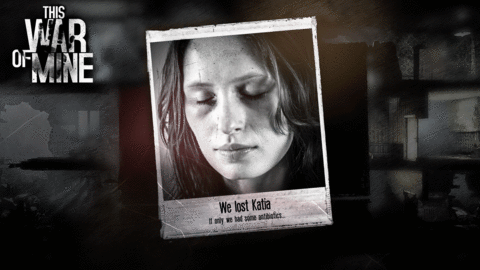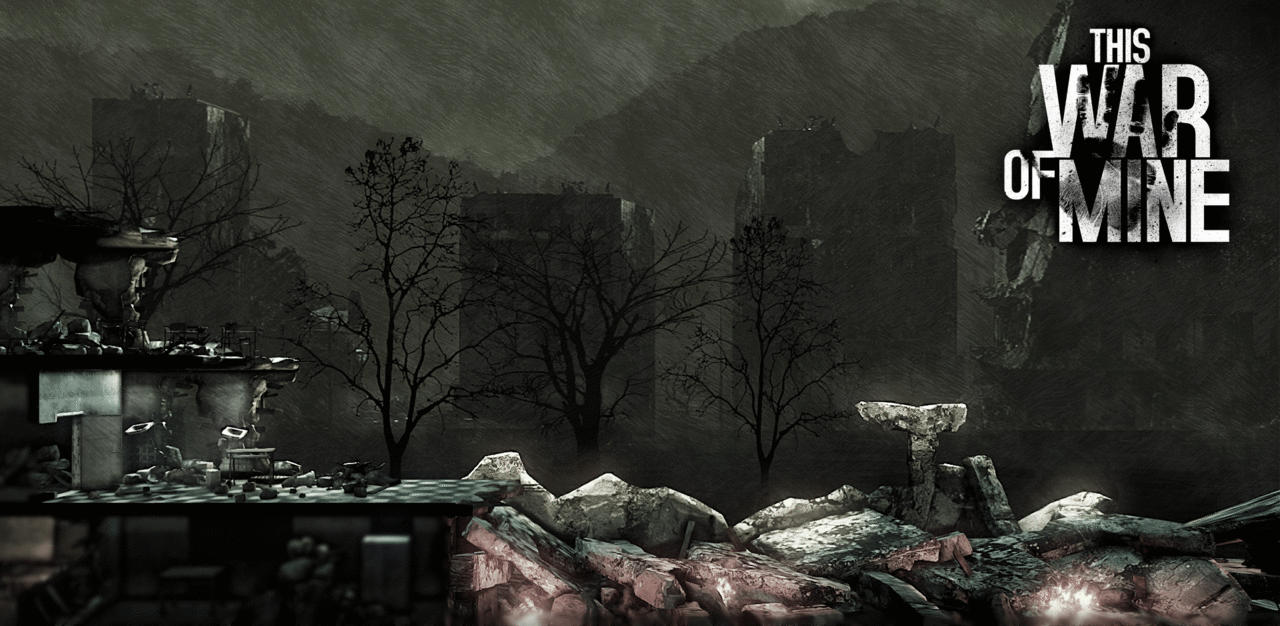Tackling the Horrors of War from a Civilian Perspective in This War of Mine
For civilians, war never changes.
Pawel Miechowski of 11 Bit Studios wants his upcoming game, This War of Mine, to challenge the way that games typically portray war by presenting it from the perspective of civilians who must survive from day to day in a war-torn city. When I met with him at the Game Developers Conference, he said to me, "You've seen the trailer, we have this Call of Duty feeling, and then bang, no, it's not about this, it's about the other side. We are breaking this scheme in the game itself as well."
Miechowski took me through a brief demonstration of some of the game's mechanics, emphasizing that the struggles your group of civilians will have to deal with in the game are the real struggles civilians face in times of war. "Whatever gameplay mechanics are in the game," he said, "it's not our idea but our translation of the facts that we know about war as seen from the perspective of civilians. So for example, I think I saw it on GameSpot actually, in the comments section, that people were writing, 'This is pretty stupid. Why can a sniper hunt me in the night?' That's what we found out in the research. For example, in the siege of Sarajevo in the early '90s--the city was under siege for four years--people couldn't have left their buildings because snipers were hunting for people to keep the city under control. In the night, they were not able to do so as effectively, but still, they were doing it, and it was risky. Same situation when it comes to water, soap, such items. We perceive them as natural because we have them, like tap water, and we have stores. When there is war breaking out, you have nothing. You are left with only what you got and your knowledge and skills. So whatever you find in the game is a translation into game mechanics of the facts of how civilians [experience] war."
Hades 2 Is Already An Exciting Sequel With Confident Changes | Technical Test Impressions Firearms Expert Reacts to Fallout 76's Guns Fallout 4 Next Gen Update Comparison Why Are Video Game Adaptations Good Now? | Spot On Fallout 4 Steam Deck Verified Gameplay ALIEN: Rogue Incursion - Announcement Teaser Trailer Stellar Blade - 13 Things I Wish I Knew S.T.A.L.K.E.R. 2: Heart of Chornobyl — Official "Not a Paradise" Trailer Honkai: Star Rail - "Then Wake to Weep" | Version 2.2 Trailer Devil May Cry: Peak Of Combat | Dante: Blazing Tempest Gameplay Trailer SAND LAND — Official Launch Trailer Sea of Thieves Season 12: Official Content Update Video
Please enter your date of birth to view this video
By clicking 'enter', you agree to GameSpot's
Terms of Use and Privacy Policy
I asked him if the siege of Sarajevo was a particular inspiration for This War of Mine, or if the game is set during any specific real-world conflict. He responded, "No, actually not. We've been looking at data of how it looks now in Syria, how it looked in Libya, how, yes, how it looked in Sarajevo, but the Yugoslavian wars are the best documented, but we want to deliver the message, and I hope the game does it well, that it could be any city; it could be your city. America is a great power--I hope it never happens--but if you are in such circumstances, you're going to behave similarly to all other civilians all around the world. You'd be doing the same things people do in Libya and Sarajevo. You're gonna be needing rainwater, you're gonna need a collector for the rainwater, you're gonna be trading water for food or for hygiene items because you will not have enough soap. You will probably need to stick to a group because on your own, you're not as effective as a group of people, because people support each other. This is the knowledge we found out, and the pattern is similar everywhere. So the same experience people have had in Syria, in Yugoslavia--moreover, because we're from Poland, which is a country that was struck by war many, many times, and I remember what my grandmother told me about her experiences during the war. She survived Nazi invasions and Soviet invasions, and her experiences were the same."
When Miechowski launched the game, I was presented with a side view of a damaged structure with holes blasted in the walls. The visuals are black and white, and have the look of an animated hand-drawn sketch. I noticed that each of the three civilians residing in the structure had a talent listed under his or her name--"handyman," "sneaks quietly," "bargaining skills." Miechowski asked me to imagine myself and people I care about in such a grim situation. "You surely have some useful skills. Other people have different skills. I know it may sound funny, but since I'm a father, I wouldn't, in a terrible situation, be sending my family to fight for anything, I would do it. We translate this into the game."
"The pattern, once again, is pretty much the same for any conflict, so this is why we don't want to say it's Sarajevo or Libya or Damascus; it could just be your city."
Miechowski used supplies that his survivors had scavenged from the area to make a few items. "I already have enough wood or a piece of metal, so I can make a shovel. I can make a bed which I know I will need since they don't have one; they just sleep on the floor." Miechowski said that he was deliberately avoiding using the common term "crafting" for the process of constructing items from acquired supplies. "It implies a gaming mindset, and I'm trying to say that this form of art is telling you about how things look when war breaks out. You don't craft; you create things. You take a hammer and nails, and from the wood, you create a table."

He moused over an item some might question the importance of in times of war and explained its value. "A moonshine still. Why? Because we found out that the most tradable item when war breaks out is [alcohol]." But he said that making booze, like making just about anything in the game, would not be easy. "First you need to find a collector and collect rainwater. Then you need to find or trade for a filter to filter your water. You need to find wood, pipes, and glass to create a distillery machine. You need yeast to create alcohol. And if you spend time on creating moonshine, you lose time for creating food. So everything will be balanced in a way forced by the situation of war."
Night rolled around and he prepared to take one of his characters out on a scavenging run. The capacity of the character's backpack is limited, and he wanted to travel light, so he chose a lock pick and a shovel and ventured out into the night. As his scavenger arrived at another damaged building, Miechowski pointed out a clock on the screen and said that it's important to keep an eye on it and return home before sunrise. He also talked about the other people you might encounter while scavenging. "People may be aggressive toward you, so you can either run away, or you can decide to kill someone and rob him. How good morally it is, you will judge yourself." As he stepped into the building, a woman panicked and retreated to a back room. "If you meet someone who's not scared of you, maybe he or she will want to trade with you or join you. If you find a hungry man, you may decide, OK, I will feed you. If you feed a hungry man, it's more likely he's going to be your friend rather than your enemy. So he may want to join you, and then you decide, OK, join me, but then you will have to care for four people or five people or six people, so you need to balance."
When it comes to weighing the cost versus the benefits of taking on new members of your group, Miechowski said, "What we found out doing the research from especially one particular interview is that when you make a decision, you can't see the consequences, but after 10 days, you'll see them." I asked him if the team making the game is conducting the research interviews themselves. "We have found a few people, yes, including one American who is a veteran of the battle of Fallujah. He's very anti-war after that event, and it's not up to me to judge why, but he saw a lot of civilians suffer during the conflict. Plus, yes, after the siege of Sarajevo, many people moved to Poland. And the pattern, once again, is pretty much the same for any conflict, so this is why we don't want to say it's Sarajevo or Libya or Damascus; it could just be your city." He mentioned the possibility of putting your own name and photo into the game for a survivor to make the experience feel more personal, which reminded me of how the Facebook connectivity option in the multiplayer for The Last of Us, which populates your camp with people from your Facebook friends list, made some players feel more invested in that experience.

After rummaging around for a bit, his scavenger attracted some hostile attention, so he fled the scene and returned to the shelter, where he had the exhausted scavenger go to sleep and instructed a hungry civilian to eat. Miechowski said that as time passes, the conditions change, and you can find new items that let you create new things. "But there's only one goal," he said, "and that's just to survive."
I asked him if he thought players would be receptive to an experience that is clearly not just about being fun but about being morally challenging. He replied, "If you play Papers, Please, on one hand, it's a very simple game. On the other, it's a very emotionally deep game. So I'm pretty convinced that we are not just talking about games but an art form." He mentioned how he saw people arguing in the comments sections of news stories about the game's announcement. "Some were going, 'Amazing concept.' And others were saying, 'No, I prefer just shooting people in the head.'" So he said that while perhaps not all gamers are receptive to games that are trying to confront meaningful issues in serious ways, there are those who are looking for games to do different things than they've traditionally done in the past. "I should try to think of what I do as a kind of art form, because why shouldn't I? In movies, in books, you're a spectator. This is the perfect media to talk about important things because they put you through the experience."
Got a news tip or want to contact us directly? Email news@gamespot.com
Join the conversation